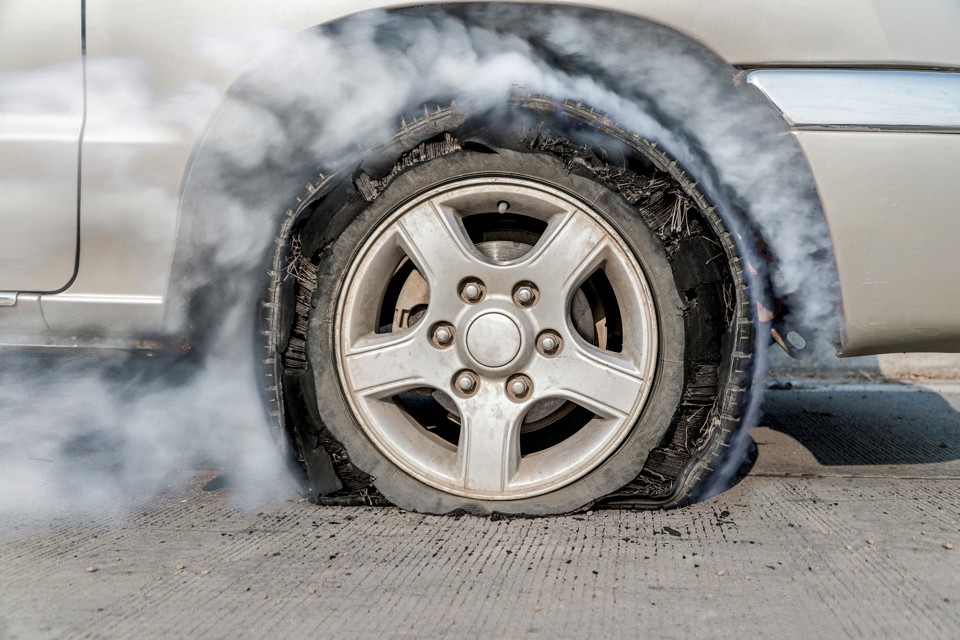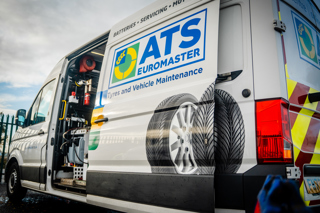Downtime is a dirty word for most fleet decision-makers, as a vehicle off the road has a negative impact on a business operation.
Verizon Connect research found vehicle off-road costs amount to an average of £6,000 a year for small- and medium-sized organisations, with 31% of fleet decision-makers losing sleep over these costs.
And tyre issues are a significant contributor to downtime: they are responsible for generating the second largest volume of roadside assistance call-outs to the RAC, after battery failure.
But there is no one simple solution.
An 18-month Highways England project across the West Midlands saw more than 1,000 pieces of tyre debris from motorways analysed by Bridgestone, which found:
- 56% of tyres failed due to road/yard debris penetration
- 18% failed due to poor inflation
- 8% failed due to poor vehicle maintenance
- 1% failed due to manufacturing defects
- 1% failed due to excessive heat
- 16% couldn’t be attributed to one particular problem
Paul Collier, key account manager at Michelin, says: “Most fleet managers would like to eradicate downtime altogether, but part of the bid to achieve that means paying close attention to tyre choice and routine tyre maintenance.”
Here, we look at key areas which influence tyre-related downtime and what fleet decision-makers can do to reduce the risk.
Tyre pressures
More than 50% of cars run on tyres which are below recommended pressures, according to research by Michelin.
“This is a staggering statistic when you consider the impact this can have on a vehicle’s steering, handling and braking, let alone causing additional wear and tear and increased fuel consumption,” says Collier.
When tyres are over- or under-inflated, the tread area in contact with the road is reduced: over-inflated tyres will make more contact with the road in the centre, while under-inflation will make more contact with the outer edges.
Both are bad news as they cause irregular wear, while traction will also be reduced, meaning tyres are less effective at gripping the road surface and bringing the car to a halt: factors which mean tyres may need replacing more often, as well as increasing the possibility of a collision.
“At Michelin, we encourage drivers to check tyre pressures at least once a month and before every long journey to help deliver long-lasting performance,” adds Collier.
Regular tyre wear checks
As well as pressures, tyres should be regularly checked for wear and damage such as bulges in sidewalls, early detection of which can reduce the risk of unnecessary vehicle downtime.
“Key things to look out for include uneven tread wear, low tread, stones or nails, and any damaged areas on the tyres, including missing valve caps,” says Collier.
David Morris, head of UK fleet at Goodyear, says checking tyres once every two weeks or at least once a month is essential to ensuring your vehicle is running efficiently.
“If you’re carrying out high mileage, checks should be carried out more regularly,” he adds.
For many van fleets, the vehicle check – including tyres – is a daily requirement for drivers, with some refusing to assign employees their first job of the day until the check has been completed.
“Ensuring fleet driver safety should always be at the top of the agenda for any business, but it’s easy to overlook how important regular checks are,” says Gil Kelly, operations director of Venson Automotive Solutions.
“These should be at the core of any tyre management policy, with staff trained to frequently carry out necessary checks, including tyre pressure, tread depth and damage.
“Written reports by drivers or the use of an online app detailing defects should be mandatory, alerting the fleet team or their fleet management provider of any issues.
“Once an issue is highlighted, appropriate action needs to be taken immediately.”
Tyre replacement policy
The current legal minimum tread depth is 1.6mm, with Kwik Fit saying the majority of companies have policies that tyres will be replaced at 2mm for safety and compliance reasons.
However, this means fleets replace tyres more frequently than they legally have to, increasing downtime while new tyres are fitted, as well as extra cost.
“We believe replacing car and van tyres at 1.6mm is the right way to go,” says Collier. “There have been calls from parts of the automotive industry to increase the minimum tread depth to 3mm, but there is no statistical link between tyre tread depths at 1.6mm and an increase in accident rates.
“Changing the legal limit will just lead to higher running costs and more frequent trips to the tyre dealer, impacting on fleet productivity and the environment.
“If you fit a premium tyre that is designed to deliver long-lasting performance, and you maintain it correctly, it will be safe down to 1.6mm.”
However, Kwik Fit points out that in the wet at 70mph, the stopping distance of a car fitted with new tyres – 8mm of tread – is calculated to be almost 100m; with 3mm this increases to 150m and with 1.6mm it is 200m – double that of a vehicle fitted with a new tyre.
Tyre procurement
The different ways in which fleets buy their tyres can have a great impact on vehicle downtime.
Therefore, fleet decision-makers should take this into account when considering their procurement method.
When vehicles are leased with the tyre maintenance included then a leasing company is likely to have a preferred deal with a service provider, usually one of the high street retail chains.
If this preferred fast-fit is not located close to an employee’s workplace or home – and they have to travel a considerable distance to reach one – then there will inevitably be downtime.
Fleet decision-makers have the right to choose where tyres are sourced from, although the leasing company is likely to specify the terms and conditions of having the vehicle back with the same brand of tyres and tread depth.
If vehicles do not have a service agreement in place – and it’s possible to have service agreements which exclude tyres – and tyres are bought by the fleet, then there could be an opportunity to reduce downtime by utilising a local fast-fit or mobile tyre fitting service.
Mobile tyre fitting services
For site-based employees, time taken driving to a fitting centre to have tyres replaced could be time spent working.
Using mobile fitting services which come to your premises and carry out the work without any disruption to the driver can be a more effective solution.
“If it isn’t managed carefully, tyre-related downtime has the potential to cost more than the price of the replacement rubber,” says Collier.
“Minor delays for the driver or, worse, a missed meeting or appointment can be the biggest sign to a customer or prospect that you are unable
to deliver.”
Companies which offer mobile fitting services also often provide on-site tyre checks to employers, highlighting any issues before they become a serious problem.
“In terms of tyre checks – which are a critical part of our vehicle health check programme – a visual inspection is followed by a more in-depth check with tread/pressure levels taken and findings recorded,” says Andy Fern, fleet sales director at Kwik Fit.
“Authorisation will then be obtained for any rectification work to be carried out.
“Tyre inspections on cars and vans are typically carried out in company car parks when employees are busy at their desks – and that means no working time is lost.”
Booking ahead
An ever-increasing number of tyre brands, sizes and types means company vehicle drivers should not simply turn up at a fitting centre unannounced, expecting their particular tyre to be in stock.
In 1997, 19 tyre sizes accounted for up to 90% of company car tyre fitments, but today this proportion is accounted for by 120 tyre sizes.
The remaining 10% comprises 1,030 different sizes.
“Tyre choice is rising by around 10% each year as vehicle manufacturers increasingly fit bespoke tyres to their new vehicles,” says Fern.
“Taking into account the choice of summer, winter and, increasingly, all-season tyres and the option of premium, mid and budget brands across a wide range of sizes, it is possible that a customers preferred choice of tyre may not be in stock.”
This means tyre replacement centres are unable to carry the levels of stock needed to guarantee a fit first time, and, as a direct consequence, drivers risk making wasted journeys and increasing tyre-related downtime.
For this reason, drivers are encouraged to plan ahead and book an appointment.
Spare wheels and puncture repair kits
Tyres account for 13% of all breakdowns attended by the RAC – its second biggest single cause for call-outs.
The motoring organisation says that more than half of new cars come with a tyre repair kit rather than a spare wheel which means a significant number of call-outs are classed as “puncture, no spare” jobs.
“Tyre-related problems represent one of the major causes of vehicle breakdown and with many of today’s company cars and vans either having a space-saver spare wheel or a temporary puncture repair kit, downtime can be impacted,” says Fern.
“When drivers can’t easily change a wheel or use a temporary puncture repair kit, it results in vehicle downtime – a recovery patrol must be summoned before that vehicle is subsequently taken to a fast-fit centre.”
If a new car does not have a spare wheel supplied as standard, fleets are often able to specify one is added as an optional extra when ordering the vehicle. Note, this might affect the car’s CO2 rating and, therefore, its tax band.
All-season or winter tyres
One way fleets can help to reduce the risk of vehicles being off the road through collisions in the colder, wetter months is to use either dedicated winter tyres or the new generation of all-season tyres.
These provide greater traction in difficult conditions than standard tyres, making it less likely collisions will occur.
Ian Foster, sales manager for car fleets at Continental, says: “Continental encourages drivers to consider changing their tyres when the temperature falls below 7C.
“At this temperature, winter tyres provide better grip and traction on snowy, icy roads. For those who experience milder winters, an all-season tyre is a suitable alternative.”
Many fast-fits offer a ‘tyre hotel’ service which allows fleets to store their standard tyres when the winter ones are in use, but Collier says this policy creates its own downtime when tyres are switched over, as well as extra cost.
“(All-season tyres) put an end to the costly process of switching tyres as the seasons change – a process which can impact heavily on vehicle availability when it affects an entire fleet,” he adds.




















Login to comment
Comments
No comments have been made yet.